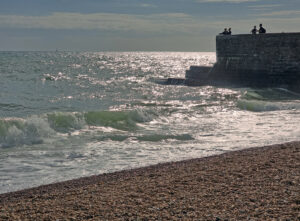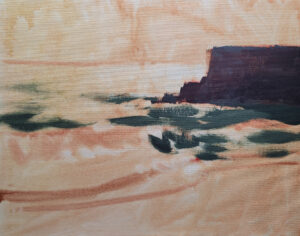
| When painting a sparkly sea, the illusion of light partly rests on the colour temperature of the greys across the canvas. Greys will be warmest (red-based) where the sun is brightest and cooler (blue-based) when furthest away or in shadow. Where mixing greys is concerned, colours vary across brands, so I encourage you to use what you have and focus on your own observational skills when discerning the colours. The mixing ideas given here are a guide. |  Reference Image |
 With a large flat, begin by washing a thin (watery) red and Lemon Yellow mix over the board. Use a slightly thicker mix to draw in the composition with the corner of the brush. Before it all dries, take a wet cloth/wipe and dab out the areas where your lightest values will be concentrated. Darkest shadows next: mix Cadmium Red, Hooker’s Green and a little Deep Violet and Titanium White for the wall. Add a little more Titanium White to the mix for the areas closest to the reflection. Add a little Ultramarine and Titanium White to the mix where the wall touches the sky. Add a little Sap Green to the mix for areas next to the shadowed sea, then take this colour and use it for the shadows in the waves.
With a large flat, begin by washing a thin (watery) red and Lemon Yellow mix over the board. Use a slightly thicker mix to draw in the composition with the corner of the brush. Before it all dries, take a wet cloth/wipe and dab out the areas where your lightest values will be concentrated. Darkest shadows next: mix Cadmium Red, Hooker’s Green and a little Deep Violet and Titanium White for the wall. Add a little more Titanium White to the mix for the areas closest to the reflection. Add a little Ultramarine and Titanium White to the mix where the wall touches the sky. Add a little Sap Green to the mix for areas next to the shadowed sea, then take this colour and use it for the shadows in the waves.
 Switch to the filbert and mix plenty of warm grey (wall colour with more Titanium White) for the sea on the right. This is an under layer – we are layering up towards the light! Add a touch of Hooker’s Green to this mix for the left-hand sea. Fill in the wave with a mix of Lemon Yellow, Ultramarine Blue, Burnt Umber and Titanium White.
Switch to the filbert and mix plenty of warm grey (wall colour with more Titanium White) for the sea on the right. This is an under layer – we are layering up towards the light! Add a touch of Hooker’s Green to this mix for the left-hand sea. Fill in the wave with a mix of Lemon Yellow, Ultramarine Blue, Burnt Umber and Titanium White.
Want to keep reading? This article is exclusive to SAA members, where you’ll also enjoy a wide range of benefits, including:
Unlock these perks and more by joining today! Become a member.
Continuing with the filbert, paint in the shadow colour of the pebbly beach, in Burnt Umber with Cadmium Red and Hooker’s…
This article is for members only. Please login or sign up to continue reading.